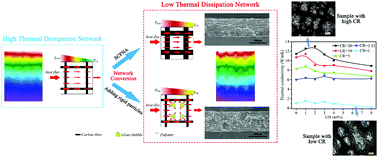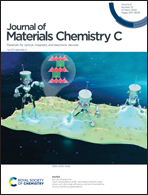Enhancing thermal conductivity via conductive network conversion from high to low thermal dissipation in polydimethylsiloxane composites†
Abstract
Thermal conductive networks (TCNs) in polymer composites are divided into high thermal dissipation TCN and low thermal dissipation TCN according to the rate of heat loss during transmission. The limited thermal conductivity (TC) enhancement in the composites prepared by traditional compounding methods was due to the high thermal dissipation of TCNs. In this study, TC enhancement based on conductive network conversion from high to low thermal dissipation was demonstrated in polydimethylsiloxane/short carbon fiber/glass bubble (PDMS/SCF/GB) composites. Two approaches, i.e., densification of the TCN by the spatial confining forced network assembly (SCFNA) method and volume exclusion by adding rigid particles, were used to realize TCN conversion from high to low thermal dissipation. Compared with the TC of PDMS/SCF (30 wt%) composites prepared by traditional compounding methods (1.053 W m−1 K−1), the TC (11.423 W m−1 K−1) of the same composites was increased by more than 9 times using the SCFNA method. The TC even presented an unexpected ∼13% enhancement to 13.004 W m−1 K−1 after adding 2 wt% GB with a relatively low TC of 0.15 W m−1 K−1. In summary, appropriate combination and optimization of these two approaches would lead to TC enhancement by one order of magnitude and more compared with traditional compounding methods.

- This article is part of the themed collection: Journal of Materials Chemistry C Lunar New Year collection 2021


 Please wait while we load your content...
Please wait while we load your content...